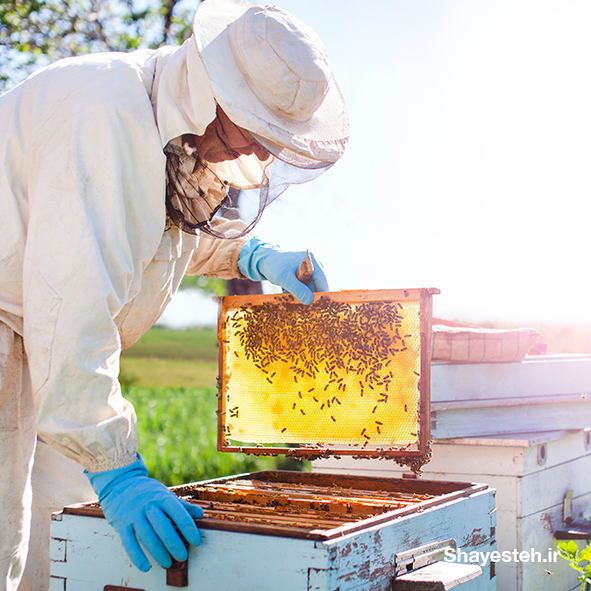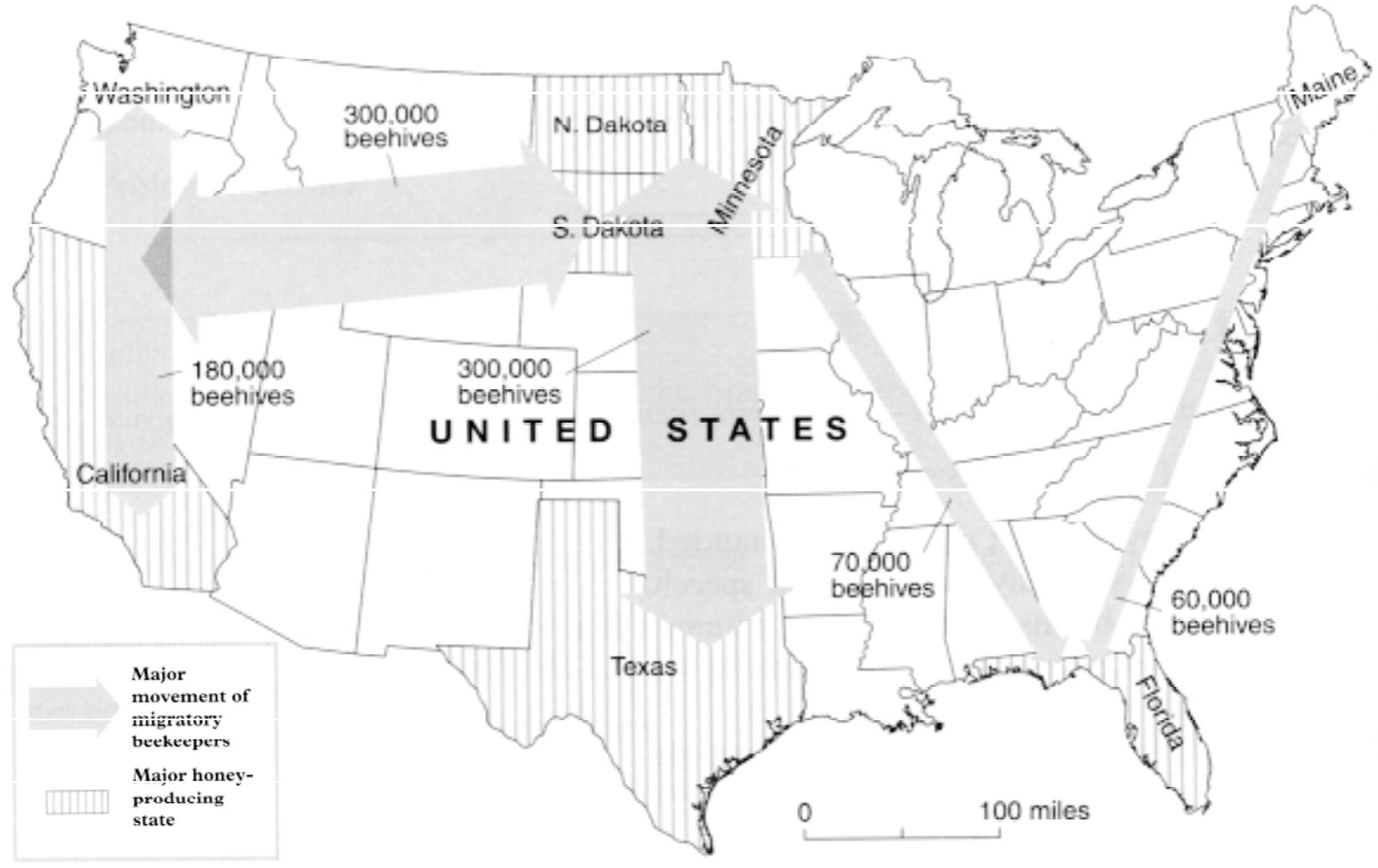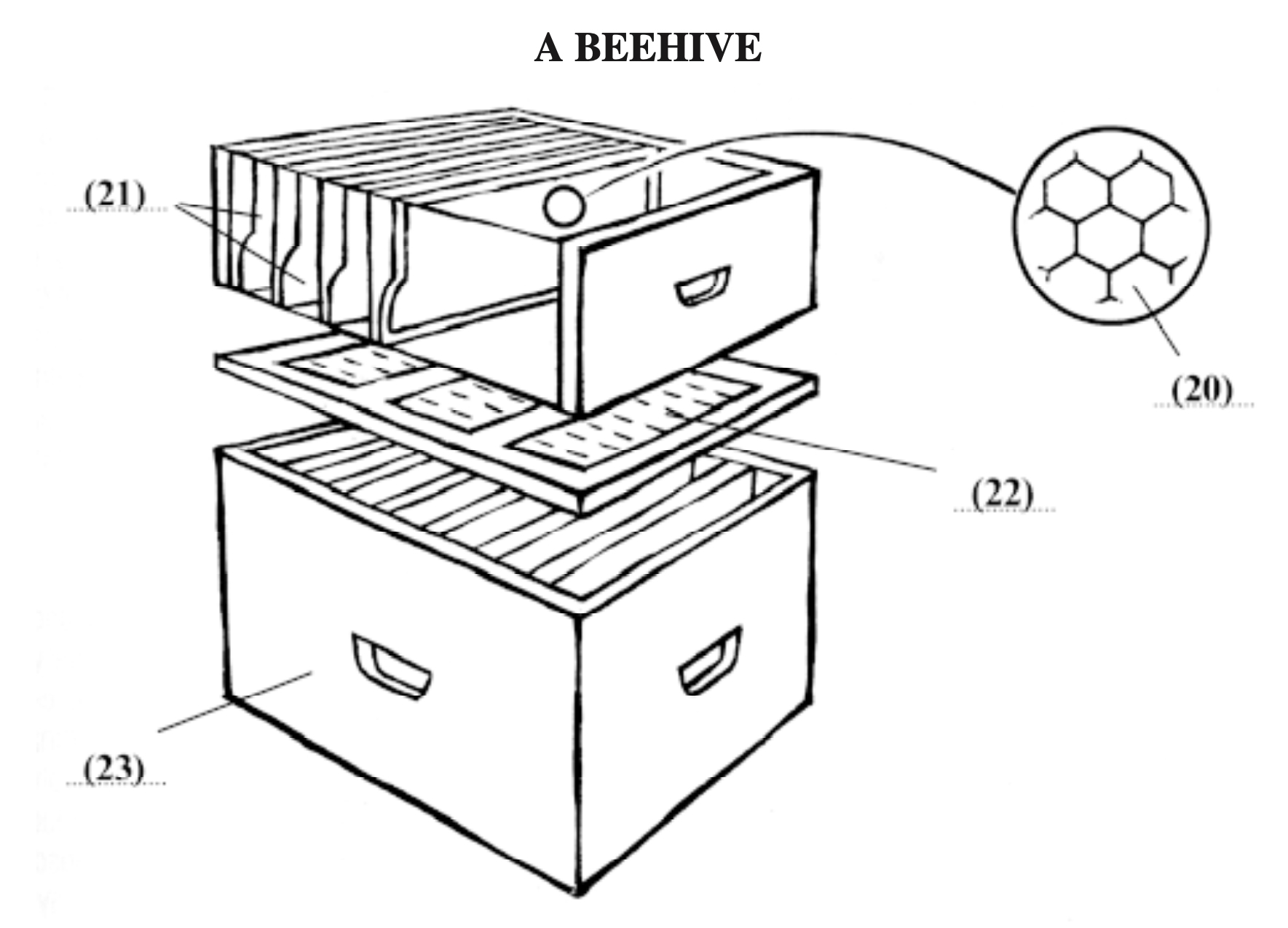در صورتی که اشکالی در ترجمه می بینید می توانید از طریق شماره زیر در واتساپ نظرات خود را برای ما بفرستید
09331464034Migratory Beekeeping
زنبورداری مهاجرتی

 Taking Wing.
Taking Wing.
گرفتن بال.
To eke out a full-time living from their honeybees, about half the nation’s 2,000 commercial beekeepers <strong>pull up stakes</strong> each spring, migrating north to find more flowers for their bees. Besides turning floral nectar into honey, these hardworking insects also pollinate crops for farmers -for a fee.
حدود نیمی از 2000 زنبوردار تجاری کشور برای بدست آوردن کل هزینه های زندگی روزمره از زنبورهای عسل خود، هر بهار <strong>محل کسب و کار خود را عوض می کنند</strong> و به شمال مهاجرت می کنند تا گل های بیشتری برای زنبورهای عسل خود پیدا کنند. این حشرات سخت کوش به ازای هزینه ای علاوه بر تبدیل شهد گل به عسل، محصولات کشاورزی را نیز برای کشاورزان گرده افشانی می کنند.
As autumn approaches, the beekeepers pack up their hives and go south, <strong>scrambling</strong> for pollination contracts in hot spots like California’s fertile Central Valley.
با نزدیک شدن به فصل پاییز، زنبورداران کندوی خود را جمع می کنند و به جنوب می روند و برای عقد قرارداد گرده افشانی در نقاط گرمی مانند دره حاصلخیز مرکزی کالیفرنیا <strong>تلاش</strong> می کنند.
Of the 2,000 commercial beekeepers in the United States about half migrate This pays off in two ways Moving north in the summer and south in the winter lets bees work a longer blooming season, making more honey — and money — for their keepers. Second, beekeepers can carry their hives to farmers who need bees to pollinate their <strong>crops.</strong>
از بین 2000 زنبوردار تجاری در ایالات متحده، تقریباً نیمی از آنها مهاجرت می کنند. این امر دو نتیجه دارد. اول، حرکت به شمال در تابستان و به جنوب در زمستان باعث می شود زنبورها فصل شکوفایی طولانی تری داشته باشند و عسل و پول بیشتری را برای نگهدارندگان خود به همراه آورند. دوم، زنبورداران می توانند کندوی خود را نزد کشاورزانی که برای گرده افشانی <strong>محصولات</strong> خود به زنبورهای عسل نیاز دارند، منتقل کنند.
Every spring a migratory beekeeper in California may move up to 160 million bees to flowering fields in Minnesota and every winter his family may haul the hives back to California, where farmers will rent the bees to <strong>pollinate</strong> almond and cherry trees.
هر بهار یک زنبوردار مهاجر در کالیفرنیا ممکن است تا 160 میلیون زنبور عسل را به مزارع گلدار در مینه سوتا منتقل کند و هر زمستان خانواده او ممکن است کندوها را به کالیفرنیا منتقل کنند، جایی که کشاورزان زنبورهای عسل را برای <strong>گرده افشانی </strong>درختان بادام و گیلاس اجاره می کنند.
Migratory beekeeping is nothing new. The ancient Egyptians moved clay hives, probably on rafts, down the Nile to follow the bloom and nectar flow as it moved toward Cairo. In the 1880s North American beekeepers experimented with the same idea, moving bees on <strong>barges</strong> along the Mississippi and on waterways in Florida, but their lighter, wooden hives kept falling into the water.
زنبورداری مهاجرتی چیز جدیدی نیست. مصریان باستان کندوهای سفالی را احتمالا روی قایق هایی به پایین رود نیل منتقل می کردند تا جریان شکوفایی و شهد را که به سمت قاهره می رفت، دنبال کنند. در دهه 1880 زنبورداران آمریکای شمالی همین ایده را آزمایش کردند و زنبورهای عسل را در <strong>لنج</strong> هایی کنار می سی سی پی و آبراه های فلوریدا حرکت دادند اما کندوهای سبک و چوبی آنها مدام در آب می افتادند.
Other keepers tried the railroad and horse- drawn wagons, but that didn’t prove practical. Not until the 1920s when cars and trucks became affordable and roads improved, did migratory beekeeping begin to <strong>catch</strong> on.
زنبورداران دیگر راه آهن و واگن های اسبی را امتحان کردند، اما عملی نبود. زنبورداری مهاجرتی در دهه 1920 که ماشین ها و کامیون ها مقرون به صرفه شدند و جاده ها بهبود یافتند، شروع به <strong>متداول</strong> شدن کرد.
For the Californian beekeeper, the pollination season begins in February. At this time, the beehives are in particular demand by farmers who have almond <strong>groves;</strong> they need two hives an acre.
برای زنبوردار کالیفرنیایی، فصل گرده افشانی از فوریه آغاز می شود. در این زمان، کشاورزان صاحب <strong>باغات</strong> بادام تقاضای ویژه این کندوهای زنبور عسل را دارند. آنها به دو کندو در هر هکتار احتیاج دارند.
For the three-week long bloom, beekeepers can hire out their hives for $32 each. It’s a <strong>bonanza</strong> for the bees too. Most people consider almond honey too bitter to eat so the bees get to keep it for themselves.
در زمان شکوفایی طولانی مدت سه هفته ای، زنبورداران می توانند کندوی خود را به ازای مبلغ 32 دلار اجاره دهند. این برای زنبورهای عسل نیز یک <strong>ثروت بادآورده </strong>است. چرا که به نظر بیشتر مردم عسل بادام برای خوردن خیلی تلخ است بنابراین زنبورها می توانند آن را برای خودشان نگه دارند.
By early March it is time to move the bees. It can take up to seven nights to pack the 4,000 or so hives that a beekeeper may own. These are not moved in the middle of the day because too many of the bees would end up <strong>homeless.</strong>
اوایل ماه مارس زمان حرکت زنبورهای عسل است. بسته بندی حدود 4000 کندویی که ممکن است یک زنبوردار داشته باشد، ممکن است تا هفت شب طول بکشد. این کندوها در وسط روز منتقل نمی شوند زیرا تعداد زیادی از زنبورهای عسل <strong>بی خانمان</strong> می شوند.
But at night, the hives are stacked onto wooden pallets, back-to-back in sets of four, and lifted onto a truck.
اما شب ها، کندوها را روی پالت های چوبی چیده و پشت به پشت در مجموعه های چهار تایی قرار می دهند و آنها را روی یک کامیون قرار می دهند.
It is not necessary to wear gloves or a beekeeper’s veil because the hives are not being opened and the bees should remain relatively quiet. Just in case some are still lively, bees can be <strong>pacified</strong> with a few puffs of smoke blown into each hive’s narrow entrance.
پوشیدن دستکش یا لباس زنبوردار ضروری نیست زیرا کندوها باز نمی شوند و زنبورها نسبتاً آرام هستند. در مواردی که برخی از زنبورها هنوز سرزنده باشند، می توان آن ها را با دمیدن مقداری دود در دهانه باریک کندوها <strong>آرام</strong> کرد.
In their new location, the beekeeper will pay the farmer to allow his bees to feed in such places as <strong>orange</strong> <strong>groves.</strong> The honey produced here is fragrant and sweet and can be sold by the beekeepers. To encourage the bees to produce as much honey as possible during this period, the beekeepers open the hives and stack extra boxes called supers on top.
در مکان جدید زنبورها، زنبوردار به کشاورز مبلغی را پرداخت می کند که اجازه دهد زنبورانش در مکانهایی مانند <strong>نارنجستانها</strong> تغذیه کنند. عسل تولید شده در اینجا معطر و شیرین است و توسط زنبورداران قابل فروش است. برای تشویق زنبورهای عسل به تولید هر چه بیشتر عسل در این دوره، زنبورداران کندوها را باز کرده و جعبه های اضافی موسوم به سوپر را روی آن قرار می دهند.
These temporary hive extensions contain frames of empty comb for the bees to fill with honey. In the brood chamber below, the bees will stash honey to eat later. To prevent the queen from crawling up to the top and laying eggs, a screen can be inserted between <strong>the brood</strong> chamber and the supers. Three weeks later the honey can be gathered.
این بسط های موقت کندوها حاوی قابهایی از شانه خالی برای پر کردن زنبورهای عسل است. زنبورها عسل را به محفظه رشد پایینی دفع می کنند تا بعدا بخورند. برای جلوگیری از خزیدن ملکه به سمت بالا و تخمگذاری، می توان یک صفحه را بین محفظه <strong>رشد</strong> و سوپرها قرار داد. سه هفته بعد می توان عسل را جمع کرد.
<strong>Foul</strong> smelling chemicals are often used to irritate the bees and drive them down into the hive’s bottom boxes, leaving the honey- filled supers more or less bee free. These can then be pulled off the hive. They are heavy with honey and may weigh up to 90 pounds each. The supers are taken to a warehouse.
مواد شیمیایی <strong>بدبویی</strong> اغلب برای تحریک زنبورها و راندن آنها به جعبه های پایین کندو استفاده می شود و سوپرهای پر از عسل را کم و بیش عاری از زنبور می کند. سپس می توان اینها را از کندو بیرون کشید. آنها به خاطر عسل سنگین شده اند و وزن هر کدام ممکن است 90 پوند باشد. سوپرها را به یک انبار می برند.
In the extracting room, the frames are <strong>lilted</strong> out and lowered into an “uncapper” where rotating blades shave away the wax that covers each cell. The uncapped frames are put in a carousel that sits on the bottom of a large stainless steel drum. The carousel is filled to capacity with 72 frames.
در اتاق استخراج، قابها <strong>جدا</strong> شده و به داخل "کلاهک" می روند، که در آن تیغه های چرخانی مومی را که هر سلول را پوشانده است می تراشند. قاب های بدون در را در یک چرخ فلک قرار می دهند که در پایین یک ظرف استوانه ای شکل بزرگ از جنس استیل ضدزنگ قرار دارد. ظرفیت چرخ و فلک با 72 فریم پر می شود.
A switch is flipped and the frames begin to whirl at 300 revolutions per minute; centrifugal force throws the honey out of the<strong> combs.</strong> Finally the honey is poured into barrels for shipment.
یک سوئیچ چرخانده می شود و فریم ها با سرعت 300 دور در دقیقه شروع به چرخیدن می کنند. نیروی گریز از مرکز عسل را از <strong>شانه</strong> ها بیرون می اندازد. در آخر عسل برای حمل در بشکه ها ریخته می شود.
After this, approximately a quarter of the hives weakened by disease, mites, or an ageing or dead queen, will have to be replaced. To create new colonies, a healthy double hive, <strong>teeming</strong> with bees, can be separated into two boxes.
پس از این، تقریباً یک چهارم کندوهای ضعیف شده به خاطر بیماری، کنه یا ملکه مسن یا مرده باید جایگزین شوند. یک کندوی دوتایی سالم <strong>مملو</strong> از زنبورهای عسل می تواند برای ایجاد کلونی های جدید، به دو جعبه جدا تقسیم شود.
One half will hold the queen and a young, already mated queen can be put in the other half, to make two hives from one. By the time the flowers bloom, the new queens will be laying eggs, filling each hive with young worker bees. The beekeeper’s family will then migrate with them to their summer location.
ملکه در یک نیمه می ماند و می توان یک ملکه جوان را که از قبل جفت شده است در نیمه دیگر قرار داد تا از یک کندو، دو کندو ساخته شود. تا زمان شکوفایی گل ها، ملکه های جدید تخمگذاری می کنند و هر کندو را پر از زنبورهای جوان کارگر می کنند. سپس خانواده زنبوردار با آنها به مکان تابستانی خود مهاجرت می کنند.
Questions & answers
Questions 13-19
The flow chart below outlines the movements of the migratory beekeeper as described in Reading Passage 2.
Complete the flow chart Choose your answers from the box at the bottom of the page and write your answers in boxes 13-19 on your answer sheet.
BEEKEEPER MOVEMENTS
|
Example Answer In February, Californian farmers hire bees to help .........pollinate...................almond trees. |
In March, beekeepers ...... (13) ..... for migration at night when the hives are ...... (14) ...... and the bees are generally tranquil. A little ...... (15) ...... can ensure that this is the case.
They transport their hives to orange groves where farmers ....... (16) ...... beekeepers for placing them on their land. Here the bees make honey.
After three weeks, the supers can be taken to a warehouse where ....... (17) ...... are used to remove the wax and extract the honey from the ...... (18) ..... .
After the honey collection, the old hives are rejected. Good double hives are ...... (19) ..... and re-queened and the beekeeper transports them to their summer base.
| List of Words/Phrases smoke chemicals pay barrels protection charge set off light split pollinate machines supers combs screen prepare full empty queens |
Questions 20-23
Label the diagram below Choose ONE OR TWO WORDS from the Reading Passage for each answer Write your answers in boxes 20-23 on your answer sheet.

Questions 24-27
Do the following statements agree with the information given in Reading Passage 2 In boxes, 24-27 write
YES if the statement agrees with the information given
NO if the statement contradicts the information given
NOT GIVEN if there is no information about this
24 The Egyptians keep bees on the banks of the Nile.
25 First attempts at migratory beekeeping in America were unsuccessful.
26 Bees keep honey for themselves in the bottom of the hive.
27 The honey is spun to make it liquid.
Answers:
14 full
15 smoke
16 charge
17 machines
18 combs
19 split
20 (hexagonal) cells// comb
21 frames (of combs)
22 screen
23 brood chamber
24 NOT GIVEN
25 YES
26 YES
27 NO
نظرات کاربران
هنوز نظری درج نشده است!